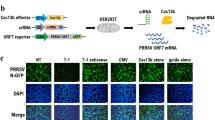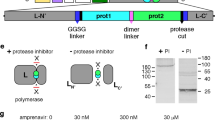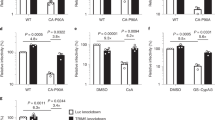Abstract
RNA interference (RNAi) is an evolutionarily conserved process by which plants and animals protect their genomes utilizing small, double-stranded RNAs to degrade target RNAs in a sequence-specific manner. Post-transcriptional gene silencing by these moieties can lead to degradation of both cellular and viral RNAs. It has recently been shown that double-stranded, small interfering RNAs (siRNAs) of 21–25 nucleotides can be transfected into relevant cells to target specific RNAs. This approach was utilized to inhibit human immunodeficiency virus type I (HIV-1) infection in human cells. siRNAs with homology to a motif in the mRNA that encodes for the HIV-1 chemokine coreceptor CXCR4 was utilized. Complementary studies via immunofluorescence microscopy and fluorescence-activated cell sorting demonstrated downregulation of CXCR4 from the surface of cells transfected with the specific siRNAs. As well, siRNAs without sequence homology to CXCR4 were used as controls and demonstrated no downregulation of CXCR4. siRNAs targeted to another chemokine coreceptor, APJ, showed specificity for downregulation of APJ but had no effects on CXCR4. Transfections with siRNAs targeting CXCR4 mRNA were shown to inhibit HIV-1 envelope fusion, which is relatively resistant to most viral inhibitors targeting chemokine coreceptors. The specificity of this effect was demonstrated by the inhibition of fusion by CXCR4-tropic and dual-tropic (CXCR4 and CCR5) envelope glycoproteins from HIV-1 on CXCR4+ indicator cells, but the lack of effects by siRNAs targeting CXCR4 mRNA on dual-tropic HIV-1 envelopes in CCR5+ indicator cells utilizing these fusion assays. Interestingly, siRNAs targeting CXCR4 selectively inhibited CXCR4-tropic cell-free virus infection of human cells but at only modest levels as compared to cell:cell fusion. siRNA may be a potential molecular therapeutic approach to alter a cellular cofactor critical for infection of human cells by relevant strains of HIV-1. The targeting of a cellular cofactor, rather than the HIV-1-specific mRNAs or genomic RNA, holds promise as the rapid mutational ability of the HIV-1 genome may obviate the potential clinical use of RNAi directly against this virus.
This is a preview of subscription content, access via your institution
Access options
Subscribe to this journal
Receive 12 print issues and online access
$259.00 per year
only $21.58 per issue
Buy this article
- Purchase on Springer Link
- Instant access to full article PDF
Prices may be subject to local taxes which are calculated during checkout





Similar content being viewed by others
References
Caplen NJ et al. Specific inhibition of gene expression by small double-stranded RNAs in invertebrate and vertebrate systems. Proc Natl Acad Sci USA 2001; 98: 9742–9747.
Elbashir SM et al. Duplexes of 21-nucleotide RNAs mediate RNA interference in cultured mammalian cells. Nature 2001; 411: 494–498.
Elbashir SM, Lendeckel W, Tuschl T . RNA interference is mediated by 21- and 22-nucleotide RNAs. Genes Dev 2001; 15: 188–200.
Fire A et al. Potent and specific genetic interference by double-stranded RNA in Caenorhabditis elegans. Nature 1998; 391: 806–811.
Wianny F, Zernicka-Goetz M . Specific interference with gene function by double-stranded RNA in early mouse development. Nat Cell Biol 2000; 2: 70–75.
Choe H et al. The orphan seven-transmembrane receptor apj supports the entry of primary T-cell-line-tropic and dualtropic human immunodeficiency virus type 1. J Virol 1998; 72: 6113–6118.
Mattick JS . Non-coding RNAs: the architects of eukaryotic complexity. EMBO Rep 2001; 2: 986–991.
Storz G . An expanding universe of noncoding RNAs. Science 2002; 296: 1260–1263.
Ahlquist P . RNA-dependent RNA polymerases, viruses, and RNA silencing. Science 2002; 296: 1270–1273.
Kitabwalla M, Ruprecht RM . RNA interference – a new weapon against HIV and beyond. N Engl J Med 2002; 347: 1364–1367.
Llave C, Kasschau KD, Carrington JC . Virus-encoded suppressor of posttranscriptional gene silencing targets a maintenance step in the silencing pathway. Proc Natl Acad Sci USA 2000; 97: 13401–13406.
Paul CP, Good PD, Winer I, Engelke DR . Effective expression of small interfering RNA in human cells. Nat Biotechnol 2002; 29: 505–508.
Pomerantz RJ . RNA interference meets HIV-1: will silence be golden? Nat Med 2002; 8: 659–660.
Sharp PA . RNA interference – 2001. Genes Dev 2001; 15: 485–490.
Song E et al. RNA interference targeting Fas protects mice from fulminant hepatitis. Nat Med 2003; 9: 347–351.
Voinnet O, Lederer C, Baulcombe DC . A viral movement protein prevents spread of the gene silencing signal in Nicotiana benthamiana. Cell 2000; 103: 157–167.
Waterhouse PM, Wang MB, Lough T . Gene silencing as an adaptive defence against viruses. Nature 2001; 411: 834–842.
Yu JY, DeRuiter SL, Turner DL . RNA interference by expression of short-interfering RNAs and hairpin RNAs in mammalian cells. Proc Natl Acad Sci USA 2002; 99: 6047–6052.
Lipardi C, Wei Q, Paterson BM . RNAi as random degradative PCR: siRNA primers convert mRNA into dsRNAs that are degraded to generate new siRNAs. Cell 2001; 107: 297–307.
Sijen T et al. On the role of RNA amplification in dsRNA-triggered gene silencing. Cell 2001; 107: 465–476.
Schwarz DS, Hutvagner G, Haley B, Zamore PD . Evidence that siRNAs function as guides, not primers, in the Drosophila and human RNAi pathways. Mol Cell 2002; 10: 537–548.
Miyagishi M, Taira K . U6 promoter-driven siRNAs with four uridine 3′ overhangs efficiently suppress targeted gene expression in mammalian cells. Nat Biotechnol 2002; 20: 497–500.
Li H, Li WX, Ding SW . Induction and suppression of RNA silencing by an animal virus. Science 2002; 296: 1319–1321.
Dornburg R, Pomrantz RJ . Gene therapy and HIV-1 infection: experimental approaches, shortcomings and possible solutions. In: Friedman H, Bendinelli M (eds) Human Retroviral Infections: Immunological and Molecular Theories. Plenum Publishers: New York, 2000, pp 307–323.
Murphy PM . The molecular biology of leukocyte chemoattractant receptors. Annu Rev Immunol 1994; 12: 593–633.
Zhang L et al. Chemokine coreceptor usage by diverse primary isolates of human immunodeficiency virus type 1. J Virol 1998; 72: 9307–9312.
Bleul CC et al. The lymphocyte chemoattractant SDF-1 is a ligand for LESTR/fusin and blocks HIV-1 entry. Nature 1996; 382: 829–833.
Doranz BJ et al. A dual-tropic primary HIV-1 isolate that uses fusin and the beta-chemokine receptors CKR-5, CKR-3, and CKR-2b as fusion cofactors. Cell 1996; 85: 1149–1158.
Feng Y, Broder CC, Kennedy PE, Berger EA . HIV-1 entry cofactor: functional cDNA cloning of a seven-transmembrane, G protein-coupled receptor. Science 1996; 272: 872–877.
Oberlin E et al. The CXC chemokine SDF-1 is the ligand for LESTR/fusin and prevents infection by T-cell-line-adapted HIV-1. Nature 1996; 382: 833–835.
Zhou N et al. Structural and functional characterization of human CXCR4 as a chemokine receptor and HIV-1 co-receptor by mutagenesis and molecular modeling studies. J Biol Chem 2001; 276: 42826–42833.
Ma Q et al. Impaired B-lymphopoiesis, myelopoiesis, and derailed cerebellar neuron migration in CXCR4- and SDF-1-deficient mice. Proc Natl Acad Sci USA 1998; 95: 9448–9453.
Nagasawa T et al. Defects of B-cell lymphopoiesis and bone-marrow myelopoiesis in mice lacking the CXC chemokine PBSF/SDF-1. Nature 1996; 382: 635–638.
Zou YR et al. Function of the chemokine receptor CXCR4 in haematopoiesis and in cerebellar development. Nature 1998; 393: 595–599.
Scarlatti G et al. In vivo evolution of HIV-1 co-receptor usage and sensitivity to chemokine-mediated suppression. Nat Med 1997; 3: 1259–1265.
Penn ML et al. CXCR4 utilization is sufficient to trigger CD4+ T cell depletion in HIV-1-infected human lymphoid tissue. Proc Natl Acad Sci USA 1999; 96: 663–668.
Schramm B et al. Viral entry through CXCR4 is a pathogenic factor and therapeutic target in human immunodeficiency virus type 1 disease. J Virol 2000; 74: 184–192.
Zhou N et al. Binding of ALX40-4C to APJ, a CNS-based receptor, inhibits its utilization as a co-receptor by HIV-1. Virology 2003; 312: 196–203.
Fujii N, Tamamura H . Peptide-lead CXCR4 antagonists with high anti-HIV activity. Curr Opin Investig Drugs 2001; 2: 1198–1202.
BouHamdan M et al. Inhibition of HIV-1 infection by down-regulation of the CXCR4 co-receptor using an intracellular single chain variable fragment against CXCR4. Gene Therapy 2001; 8: 408–418.
Chen JD et al. Inactivation of HIV-1 chemokine co-receptor CXCR-4 by a novel intrakine strategy. Nat Med 1997; 3: 1110–1116.
Doranz BJ et al. Safe use of the CXCR4 inhibitor ALX40-4C in humans. AIDS Res Hum Retroviruses 2001; 17: 475–486.
Ge Q et al. RNA interference of influenza virus production by directly targeting mRNA for degradation and indirectly inhibiting all viral RNA transcription. Proc Natl Acad Sci USA 2003; 100: 2718–2723.
Gitlin L, Karelsky S, Andino R . Short interfering RNA confers intracellular antiviral immunity in human cells. Nature 2002; 418: 430–434.
Seo MY, Abrignani S, Houghton M, Han JH . Small interfering RNA-mediated inhibition of hepatitis C virus replication in the human hepatoma cell line Huh-7. J Virol 2003; 77: 810–812.
Wilson JA et al. RNA interference blocks gene expression and RNA synthesis from hepatitis C replicons propagated in human liver cells. Proc Natl Acad Sci USA 2003; 100: 2783–2788.
Capodici J, Kariko K, Weissman D . Inhibition of HIV-1 infection by small interfering RNA-mediated RNA interference. J Immunol 2002; 169: 5196–5201.
Coburn GA, Cullen BR . Potent and specific inhibition of human immunodeficiency virus type 1 replication by RNA interference. J Virol 2002; 76: 9225–9231.
Jacque JM, Triques K, Stevenson M . Modulation of HIV-1 replication by RNA interference. Nature 2002; 418: 435–438.
Lee NS et al. Expression of small interfering RNAs targeted against HIV-1 rev transcripts in human cells. Nat Biotechnol 2002; 20: 500–505.
Novina CD et al. siRNA-directed inhibition of HIV-1 infection. Nat Med 2002; 8: 681–686.
Surabhi RM, Gaynor RB . RNA interference directed against viral and cellular targets inhibits human immunodeficiency Virus Type 1 replication. J Virol 2002; 76: 12963–12973.
Qin XF, An DS, Chen IS, Baltimore D . Inhibiting HIV-1 infection in human T cells by lentiviral-mediated delivery of small interfering RNA against CCR5. Proc Natl Acad Sci USA 2003; 100: 183–188.
Doranz BJ et al. A small-molecule inhibitor directed against the chemokine receptor CXCR4 prevents its use as an HIV-1 coreceptor. J Exp Med 1997; 186: 1395–1400.
Kusunoki A et al. Antisense oligodeoxynucleotide complementary to CXCR4 mRNA block replication of HIV-1 in COS cells. Nucleosides Nucleotides 1999; 18: 1705–1708.
McKnight A et al. Inhibition of human immunodeficiency virus fusion by a monoclonal antibody to a coreceptor (CXCR4) is both cell type and virus strain dependent. J Virol 1997; 71: 1692–1696.
Murakami T et al. A small molecule CXCR4 inhibitor that blocks T cell line-tropic HIV-1 infection. J Exp Med 1997; 186: 1389–1393.
O'Brien WA et al. Anti-human immunodeficiency virus type 1 activity of an oligocationic compound mediated via gp120 V3 interactions. J Virol 1996; 70: 2825–2831.
Schols D et al. Inhibition of T-tropic HIV strains by selective antagonization of the chemokine receptor CXCR4. J Exp Med 1997; 186: 1383–1388.
Tamamura H et al. Development of specific CXCR4 inhibitors possessing high selectivity indexes as well as complete stability in serum based on an anti-HIV peptide T140. Bioorg Med Chem Lett 2001; 11: 1897–1902.
Edinger AL et al. An orphan seven-transmembrane domain receptor expressed widely in the brain functions as a coreceptor for human immunodeficiency virus type 1 and simian immunodeficiency virus. J Virol 1998; 72: 7934–7940.
Hosoya M et al. Molecular and functional characteristics of APJ. Tissue distribution of mRNA and interaction with the endogenous ligand apelin. J Biol Chem 2000; 275: 21061–21067.
Cayabyab M et al. Apelin, the natural ligand of the orphan seven-transmembrane receptor APJ, inhibits human immunodeficiency virus type 1 entry. J Virol 2000; 74: 11972–11976.
Zhou N et al. Cell–cell fusion and internalization of the CNS-based, HIV-1 co-receptor, APJ. Virology 2003; 307: 22–36.
Gabuzda D, He J, Ohagen A, Vallat AV . Chemokine receptors in HIV-1 infection of the central nervous system. Semin Immunol 1998; 10: 203–213.
Mukhtar M et al. Primary isolated human brain microvascular endothelial cells express diverse HIV/SIV-associated chemokine coreceptors and DC-SIGN and L-SIGN. Virology 2002; 297: 78–88.
Hesselgesser J et al. CD4-independent association between HIV-1 gp120 and CXCR4: functional chemokine receptors are expressed in human neurons. Curr Biol 1997; 7: 112–121.
Krichevsky AM, Kosik KS . RNAi functions in cultured mammalian neurons. Proc Natl Acad Sci USA 2002; 99: 11926–11929.
Martinez MA et al. Suppression of chemokine receptor expression by RNA interference allows for inhibition of HIV-1 replication. Aids 2002; 16: 2385–2390.
Rucker J et al. Cell–cell fusion assay to study role of chemokine receptors in human immunodeficiency virus type 1 entry. Methods Enzymol 1997; 288: 118–133.
Nussbaum O, Broder CC, Berger EA . Fusogenic mechanisms of enveloped-virus glycoproteins analyzed by a novel recombinant vaccinia virus-based assay quantitating cell fusion-dependent reporter gene activation. J Virol 1994; 68: 5411–5422.
Acknowledgements
We thank Dr B Cullen (Duke University) for kindly providing the luciferase-reported HIV-1 proviral clones and Ms Rita M Victor and Ms Brenda O Gordon for excellent secretarial assistance. The U87MG reporter cell line was obtained from the AIDS Reagent Repository (NIH), submitted by Drs Deng and D Littman. This work was supported in part by USPHS Grants NS27405, MH58526, NS44513 and NS41864 to RJP.
Author information
Authors and Affiliations
Rights and permissions
About this article
Cite this article
Zhou, N., Fang, J., Mukhtar, M. et al. Inhibition of HIV-1 fusion with small interfering RNAs targeting the chemokine coreceptor CXCR4. Gene Ther 11, 1703–1712 (2004). https://doi.org/10.1038/sj.gt.3302339
Received:
Accepted:
Published:
Issue Date:
DOI: https://doi.org/10.1038/sj.gt.3302339
Keywords
This article is cited by
-
New opportunities for designing effective small interfering RNAs
Scientific Reports (2019)
-
HIV-1 inhibition in cells with CXCR4 mutant genome created by CRISPR-Cas9 and piggyBac recombinant technologies
Scientific Reports (2018)
-
SgRNA Expression of CRIPSR-Cas9 System Based on MiRNA Polycistrons as a Versatile Tool to Manipulate Multiple and Tissue-Specific Genome Editing
Scientific Reports (2017)
-
A Novel Approach to Block HIV-1 Coreceptor CXCR4 in Non-toxic Manner
Molecular Biotechnology (2014)
-
The use of cell-delivered gene therapy for the treatment of HIV/AIDS
Immunologic Research (2010)



